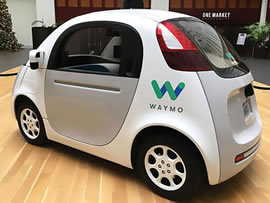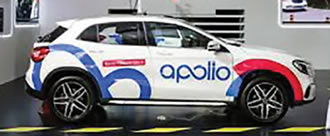 |
IN FOCUS |
|
by Matthew W. Daus, Esq. |
||
There has been a tremendous amount of attention and media hype involving "Driverless Cars" or "Autonomous Vehicles" (AVs) over the last year or so. This enerated excitement, concern and misunderstandings as to how, what and when such technology will be commonplace on our roads.
I have been very involved in studying Autonomous and Connected Vehicle (CV) transportation technology and policy. I most recently co-chaired an emerging technology forum of government and private sector transportation lawyers at the 56th Annual Transportation Law Workshop organized by the Transportation Research Board of the National Academy of the Sciences.
Also, I have been very involved in the annual AV/CV symposia organized by the U.S. Department of Transportation’s Research Center at the City University of New York. I moderated a high level policy discussion with NY State and local elected and appointed transportation officials for this 5th annual event. The event focused on impacts to the taxicab and for-hire vehicle industries, as well as identifying principles for testing in urban centers.[1]
I have also partnered with the International Association of Public Transit (UITP) to train RTA (Roads and Transport Authority) government employees in Dubai about AV/CVs. I have organized sessions with top experts at the International Association of Transportation Regulators’ conferences starting back in 2015.

Driverless vehicles are motor vehicles in which internal vehicle systems operate all driving functions without human input.[2] People have imagined driverless cars since the 1920s. At the time, driverless cars were more commonly known as "phantom autos," and were remotely controlled by radio waves.
The first actual autonomous vehicle was created in the 1980s, and used a Light Detection and Ranging ("LIDAR") system. There exists various degrees of vehicle automation ranging from light automation (i.e., "cruise control") to full automation—a state where the vehicle is in complete control of all driving functions at all times.
In 2013, the National Highway Traffic Safety Administration ("NHTSA") announced a policy concerning vehicle automation wherein the agency defined five automation levels. It was amended and adopted in September 2016.[3 ]
Much like AVs, Connected Vehicles ("CVs") are able to communicate with other "smart" vehicles on the road, but they are not necessarily fully autonomous. CVs use wireless communication that is supported by dedicated short range communications ("DSRC").
By gathering data from other vehicles, CVs anonymously transmit traffic and road condition information to other CVs and connected transportation networks with applications that include crash warning or avoidance functions.
Currently, the connected vehicle environment includes three major approaches to communication:
Nevada was the first state to authorize the operation of AVs in 2011. Since then, 19 other states and the District of Columbia have passed legislation related to AVs. Google first began testing self-driving car technology in 2009. The Google self-driving car project became Waymo in 2016, a stand alone company under the Alphabet corporate umbrella.
 Photo credit: cnbc.com
Photo credit: cnbc.comTesla Inc. started testing four self-driving cars on California’s public roads in October 2016, a month after Uber began testing self-driving cars in Pittsburgh. Uber then expanded to Arizona after it was banned from operating AVs in San Francisco in December 2016.
By January 2017, driverless cars or buses were being tested on public roads in the cities of Las Vegas, Boston, and Chandler, Arizona. That same month, the U.S. Department of Transportation designated 10 proving ground pilot sites to encourage testing and information sharing around automated vehicle technologies.
In February 2017, Waymo sued Uber over the alleged theft of its intellectual property covering driverless car technology by an employee who created a start-up that was later acquired by Uber.[4]
In June 2017, it was announced that Audi of America Inc. would be the first to test AVs in New York State as part of a pilot program initiated by Governor Cuomo. Reported accidents involving vehicles using self-driving technology have raised concerns about the safety of AVs.
A Tesla driver was killed in May 2016 while using the semi-autonomous Autopilot mode on his Model S in the first fatality involving a self-driving car. Similarly, a collision involving one of Uber’s self-driving vehicles was reported in Arizona.
Transportation Network Companies (TNCs, like Uber and Lyft) and their smartphone app competitors (i.e., Gett), vehicle manufacturers, and technology companies, are now partnering in the hope to create new for-hire vehicle fleets as the auto industry prepares for less car owners and more shared rides.
It seems that most every smartphone transportation app has an automobile and technology partner or partners at the AV dance. While Uber has partnered with Volvo, Daimler and Didi Chuxing, Lyft is working with General Motors Co., Jaguar Land Rover and Alphabet Inc.’s Waymo in a bid to develop its own fully autonomous vehicles.
On July 5, 2017, Chinese search giant Baidu announced that more than 50 companies, including big names in the auto and tech industries such as Ford, Daimler, Nvidia, Intel, and Microsoft, have joined its Apollo self-driving car platform.
 Photo credit alltechbuzz.net
Photo credit alltechbuzz.netOther examples of reported partnerships include: Toyota working with Microsoft and Nvidia; Waymo partnering with Lyft, Avis and Fiat Chrysler Automobiles. Hertz announced a collaboration with Apple, RideScout with GlobeSherpa, while Volkswagon and Gett and Bosh created an alliance with Nvidia, Daimler and Baidu.
Sharing data, integrating hardware and software, and collaborating on open source platforms, are all incentives for these companies to work together to win the AV race.
Meanwhile, many legal, regulatory and policy issues and concerns will need to be addressed before AVs become part of our daily lives, including the taxicab and for-hire transportation industries. Here is a sampling of some of the issues:
However, fully autonomous vehicles may turn out to be inaccessible for wheelchair passengers. Once you remove the driver, who is there to assist passengers in wheelchairs?
So what does it all mean for the taxicab and for-hire ground transportation industry? In my view, not much right now in terms of labor displacement or other major changes. However, the business relationships underlying economics/financing and lawsuits involving AV players could have a profound impact on the viability of the smartphone app transportation companies in the market.
In the short term (next few years), the race to develop and patent AV designs/inventions has more to do with securing intellectual property rights now than with actually mass manufacturing or using AVs right away. For example, the lawsuit against Uber by Waymo, if it halts Uber’s AV program, could be a huge blow to Uber’s ability to compete against incumbent and new ground transportation players.
Uber is likely counting on increasing or justifying its company valuation by landing the patent rights to its prototype vehicle as well as persuing manufacturing and related business deals. This would help Uber to raise more private capital or pave the way to an Initial Public Offering.
Uber will, as well, continue to subsidize driver earnings and fares to increase market share. The failure to do so, with billions in losses mounting, could lead to Uber losing market share, and may fuel the rise of other TNCs or a comeback of the incumbent taxi and for-hire industries.
In the mid-term (between 3 and 5 years from now), more AV testing may lead to partnerships where certain select players, like TNCs and car sharing companies, may begin deploying AVs before the widespread sale of personal AVs to the general public. However, for-hire or car-sharing (i.e. Car2Go) AV deployment would probably be limited to restricted lanes or geographic areas, and not likely in dense urban environments where taxis and FHVs thrive.
We are more likely to first see AV buses and freight vehicles platooning on special highway lanes, and at confined areas such as airport premises, Disney, universities and retirement communities.
AV technology will be here very quickly with safe vehicles that work well. However, the ability for the multitude of federal, state and local agencies to get on the same page to deploy them right away will be challenging.
We may get to levels 3 or 4 in less than 10 years for all vehicles on the road, but getting to that last level of removing the driver will be a long stretch. So taxicab, TNC and for-hire drivers losing their jobs will not happen for a very long time.
When AVs hit the road at level 5, it is likely that all manufacturers will have them so there will be a level playing field. TNCs, taxis and FHVs will all have the option to increase their profit margins by not having drivers.
On the issue of insurance, CVs and higher levels of automation are likely to prompt significant reduction in insurance premiums. New insurance products that may benefit the independent contractor driver, with product liability for AV defects and other new forms of insurance, may be purchased potentially by transportation companies or auto manufacturers.
The increased safety options will minimize risks and lead to benefits on insurance sooner rather than later. Only time will tell when, where and how, but these are exciting times, indeed. AV/CV technology issues will eventually work themselves out, however, not as quickly as the media and private tech companies say or would like.
So mothers everywhere need not worry about their children driving with "no hands" anytime soon, and for-hire drivers can breathe a sigh of relief that their jobs will be there for a long time to come.
................................................................................................................................................................